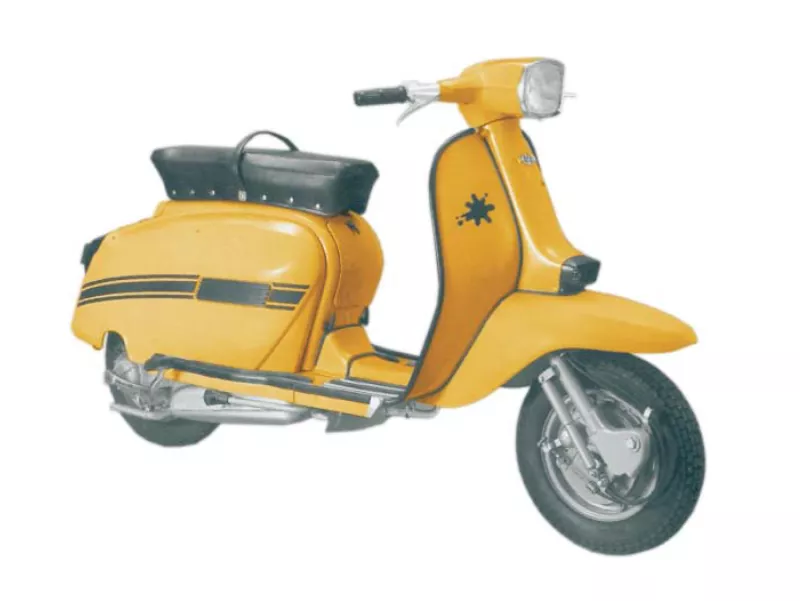Postage free from 99€ (DE)
High customer satisfaction

Lambretta GP/DL 200
The GP/DL series replaced all Li, Special, SX and TV models in 1969. In most countries, the scooters are marketed under the name DL. In Great Britain, on the other hand, a special approach was taken similar to the GT and the DL was simply called the GP. Times seem to have changed, and the Gran Turismo has been overtaken by the Gran Prix speedsters. Advertising motifs with slogans such as 'Real Stopper' or 'Real Goer' fit perfectly.
The DL is available in the familiar three displacement classes, but all engines have been noticeably revised.
The bodywork, which was completely redesigned by Studio Bertone, is shorter and tighter. The leg shield is lower and the cascade is also shorter. The steering head and headlamp are now rectangular. The mudguard has a much sportier styling. The shorter fork, the rims and the brake drums are now painted silver. The rear light is made of black plastic, the chrome trim has disappeared and been replaced by black plastic parts. The no-frills side hoods have black rally stripes glued vertically halfway up and black dummy radiator grilles are embedded in the front third.
The DL 125 adopts the lifted engine from the 125 Special. The engine numbers still start with the abbreviation Li125S. Apart from the rear sprocket, which is no longer riveted but milled from the solid, not much has changed. Except for the crankshaft: this has a much thicker stump to accommodate the pole wheel. Even though the DL 150 adopts the abbreviation from the SX 150 engines, a lot more has been done here. In addition to the pinion, crankshaft and intake bellows, the cylinder has a new porting layout. With the SH 22 carburetor, the power output hardly increases (9.4 hp), but the rev range is broader.
The changes to the DL 200 engine were less to do with the abbreviation, which is very familiar to us with SX 200, but rather with the carburetor, gear ratio, crankshaft and ignition. The overall transmission ratio of 5.22 is significantly shorter than the 4.80 of the SX 200 transmission. This means that the engine can still rev fully even under unfavorable conditions. The gearbox itself was taken from the Li125S, but with a longer ratio thanks to an 18/47 pinion combination. Together with the SH 22 carburetor, the DL 200 thus achieves a top speed of 110 km/h with improved acceleration. While very few DL models were delivered with an intake bellows with overflow valve, this soon disappeared.
The ultimate improvement to the DL 200 was the introduction of the DL 200 electronic model. A small sticker on the right-hand side of the leg plate indicates that a vehicle with electronic ignition is waiting impatiently to be put into service. The ignition was developed in collaboration with Ducati. In principle, it anticipated the ignition system of a scooter built to this day by around a decade. Unfortunately, no exact quantities of the electronic are known, as it was built from June 1970 in parallel with versions with contact ignition.
The GP/DL models came in a new color scheme. In keeping with the late sixties, bold colors dominate. The DL 125 is available in turquoise. (Rarely also in white.) The DL 150 is delivered in Italy in a vibrant red. A two-tone paint finish is also available for export markets. An all-white scooter is garnished with a choice of red or blue side covers, cascade and mudguards. The DL 200 is delivered to the Italian domestic market in ochre, while the export markets are offered a choice of ochre and red.
A few minor changes were made during the construction period. On earlier mopeds, the horn grille and the grille under the seat were still painted in the vehicle color, but these were later replaced by unpainted black plastic parts. The aluminum levers for the fuel tap and choke and the grey plastic glove compartment are also replaced with black plastic. The stud bolts and nuts on the engine cover of the last GP/DL models were also dropped in favor of M6 x 30 bolts.
In April 1971, the last GP/DL scooters rolled out of the Innocenti halls. With 15,300 125s, 21,050 150s and 9,302 200s, it is unfortunately not possible to speak of very high numbers. Fortunately, the production line with all the tools was sold to India, where the GP 200 continued to be built.
DL/GP - 1st version
(January 1969 to mid 1970)
Horn grille, fuel filler flap and grille under the seat are made of metal.
DL/GP - 2nd version
(mid 1970 to April 1971)
Horn grille, fuel filler flap and grille under the seat are made of plastic
